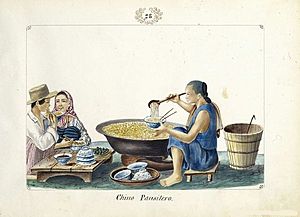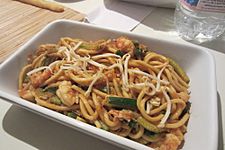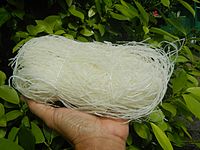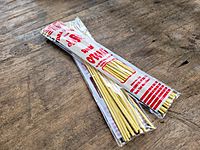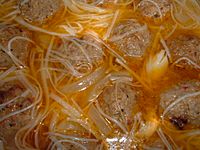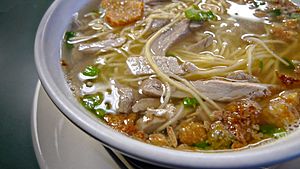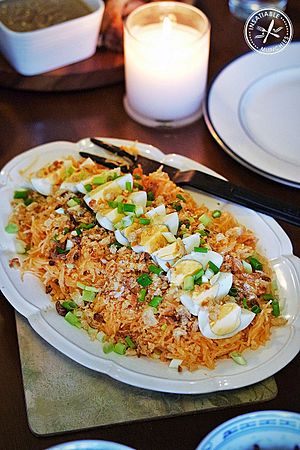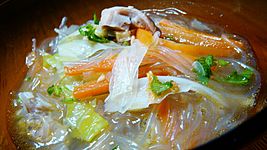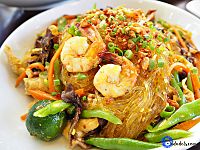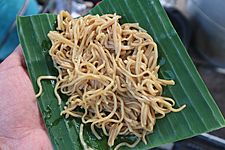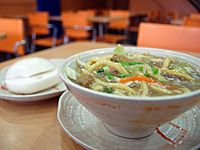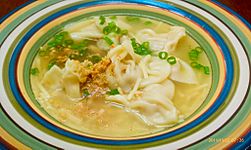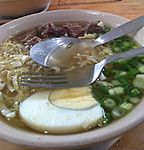Pancit facts for kids
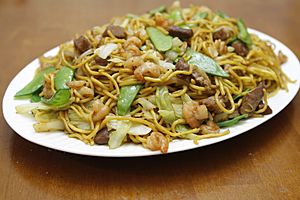
Pancit canton, the most popular type of pancit
|
|
| Alternative names | Pansít |
|---|---|
| Type | Noodle |
| Place of origin | Philippines |
Pancit (pronounced pan-SIT) is a popular and tasty noodle dish from the Philippines. It's not just one dish, but a whole group of different noodle meals! You can find many kinds of pancit. They are often named after the type of noodles used, how they are cooked, where they come from, or what ingredients are in them. Most pancit dishes are served with a small, sour fruit called calamansi.
Noodles first came to the Philippines a long time ago. They were brought by Chinese immigrants. Over many years, these noodle dishes became a big part of Filipino cooking. They even added some Spanish touches! There are many kinds of pancit all over the Philippines. Each region often uses ingredients that are easy to find there. Some special kinds of pancit don't even use noodles. Instead, they use strips of coconut, young papaya, mung bean sprouts, bamboo shoots, or even seaweed.
Contents
What is Pancit?
The word pancit comes from a Chinese language called Hokkien. It means something like "convenient food" or "wonton noodles." In the Filipino language, pansít is the general word for any kind of noodles. You can find many different kinds of noodles in Filipino supermarkets. People can cook these noodles at home.
Noodle dishes are also very common in local restaurants. Places that specialize in serving pancit are called panciterias. Pancit has changed over time in Filipino cooking. It now combines Chinese and Spanish cooking styles. It also uses many local ingredients.
How Pancit is Cooked
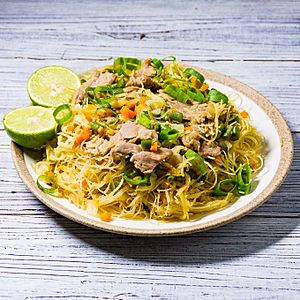
Most pancit dishes are cooked by sautéing. This means frying ingredients quickly in a little oil. They usually start with garlic and onions. Then, vegetables like carrots, green beans, and cabbage are added. Meats like different kinds of Filipino sausages (longganisa) or seafood are also common. These can include shrimp, fish, or squid.
The sauce for pancit can be different for each recipe. Common sauce ingredients include soy sauce, vinegar, or fish sauce (patis). Sometimes, special ingredients like coconut milk or crab fat are used.
Pancit can also be cooked in a broth, which is a flavorful soup. Or, it can be braised, meaning cooked slowly in liquid. Almost all pancit dishes are served with slices of calamansi. Squeezing this fruit over the noodles adds a fresh, tangy taste.
Common Toppings and Sides
Pancit dishes often have many tasty toppings. These can include smoked fish (tinapa), fried garlic, or crispy pork cracklings (chicharon). Other toppings might be chili peppers, shallots, or ground black pepper. Some people add peanuts or sliced hard-boiled eggs. In some areas, they might even add slices of kamias fruit.
Types of Noodles Used
Pancit dishes are usually named after the kind of noodles they use. Here are some common types:
- Canton: These are egg noodles, usually round.
- Bihon: These are very thin rice vermicelli noodles.
- Lomi: These are thick egg noodles.
- Miki: These are soft, yellow egg noodles, usually flat.
- Misua or Miswa: These are very thin wheat vermicelli noodles.
- Palabok: These are yellow cornstarch noodles.
- Sotanghon: These are clear glass noodles.
- Odong: These are yellow flour noodles.
- Types of pancit noodles
-
Canton (egg noodles, usually round)
-
Bihon (rice vermicelli)
-
Miki (soft yellow egg noodles, usually flat)
-
Sotanghon (bean vermicelli)
-
Odong (yellow flour noodles)
-
Misua or miswa (wheat vermicelli)
Pancit for Celebrations
Pancit is eaten every day, but it is also a popular "comfort food." You can eat pancit by itself. But it is also often eaten with white rice, bread like pandesal, or steamed rice cakes called puto.
Pancit dishes are often served at parties, events, and festivals. This is because they are easy to cook in large amounts. Many people believe that eating noodles on your birthday brings good luck and a long life. This belief comes from Chinese Filipinos. Because of this, pancit is a common dish at birthday celebrations. Many Chinese restaurants in the Philippines even have "birthday noodles" on their menu.
Popular Pancit Dishes
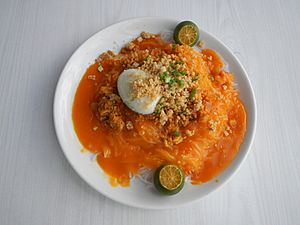
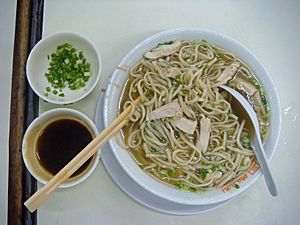
There are many different kinds of pancit dishes across the Philippines. Here are some of the most well-known ones:
- Batchoy – This is a noodle soup. It is made with pork, crispy pork cracklings, and beef. It comes from Iloilo City.
- Pancit Bam-I – Also called Pancit Bisaya. This dish from Cebu mixes two kinds of noodles: bihon (rice) and canton (wheat). They are stir-fried together.
- Pancit bihon guisado – Often just called pancit bihon. This is a very common type of pancit. It uses thin rice noodles fried with soy sauce and vegetables.
- Pancit canton – This is the Filipino version of lo mein or chow mein. It can be an instant noodle dish or a stir-fried one.
- Pancit choca (or Pancit pusít) – This is a unique black pancit from Cavite. It gets its color from squid ink and uses bihon noodles.
- Pancit habhab – A special dish from Lucban, Quezon. It is served on banana leaves. People eat it directly without using forks or spoons!
- Pancit lomi – This thick noodle soup is originally from Batangas. You can find it in many eateries across the country.
- Pancit Malabon – This dish uses thick rice noodles with many toppings. It comes from Malabon.
- Pancit mami – This is a round egg noodle soup.
- Pancit odong – A noodle dish from the Visayas and Mindanao. It uses yellow flour noodles called odong. It is often cooked with canned sardines and vegetables.
- Pancit palabok – This dish uses thinner cornstarch noodles. It has a bright orange shrimp-based sauce. It is topped with shrimp, crushed chicharrón, smoked fish flakes, and hard-boiled eggs.
- Pancit sotanghon – This is a clear cellophane noodle soup. It has a chicken broth base. It usually includes chicken and green onions.
- Pansit Tuguegarao or Batil Patong – This special noodle dish comes from Tuguegarao. It has a sauce made from beef broth and soy. It is served with two side dishes: a small cup of egg-drop soup and a mix of onions, vinegar, and chili peppers.
Gallery of Pancit Variants
- Variants of pancit
-
"Saucy" pancit canton, a common braised version
-
Sotanghon guisado with calamansi
-
Pancit Molo, which uses wontons instead of noodles
Pancit Without Noodles
Some types of pancit are unique because they don't use traditional noodles. Instead, they use other ingredients:
- Pancit buko – This dish uses long strips of young coconut instead of noodles.
- Pancit estacion – From Tanza, Cavite, this one uses mung bean sprouts instead of noodles.
- Pancit labong – An older version of Pancit Malabon. It uses thin strips of bamboo shoots instead of noodles.
- Pancit Molo – This is a wonton soup. The wonton wrappers act as the "noodles" in the broth.
- Pancit papaya – This dish uses thin strips of young papaya fruit instead of noodles.
- Seaweed pancit – From Tiwi, Albay, this uses noodles made from seaweed. It is healthy and can be cooked like pancit canton or spaghetti.
Instant Pancit
You can also find instant versions of pancit in stores. These are very popular because they are affordable and easy to make. The most common instant flavors are mami (a soup) and pancit canton. Other Filipino noodle styles are also being made into instant versions for the market.
See also
 In Spanish: Pancit para niños
In Spanish: Pancit para niños


